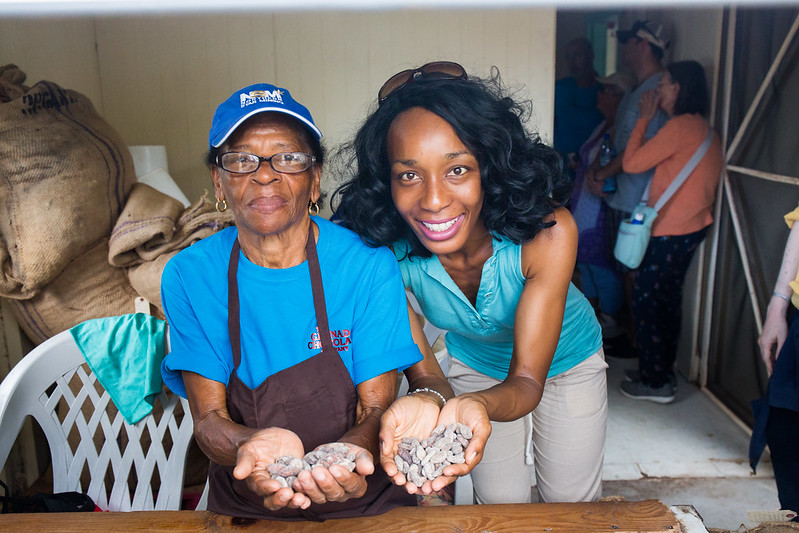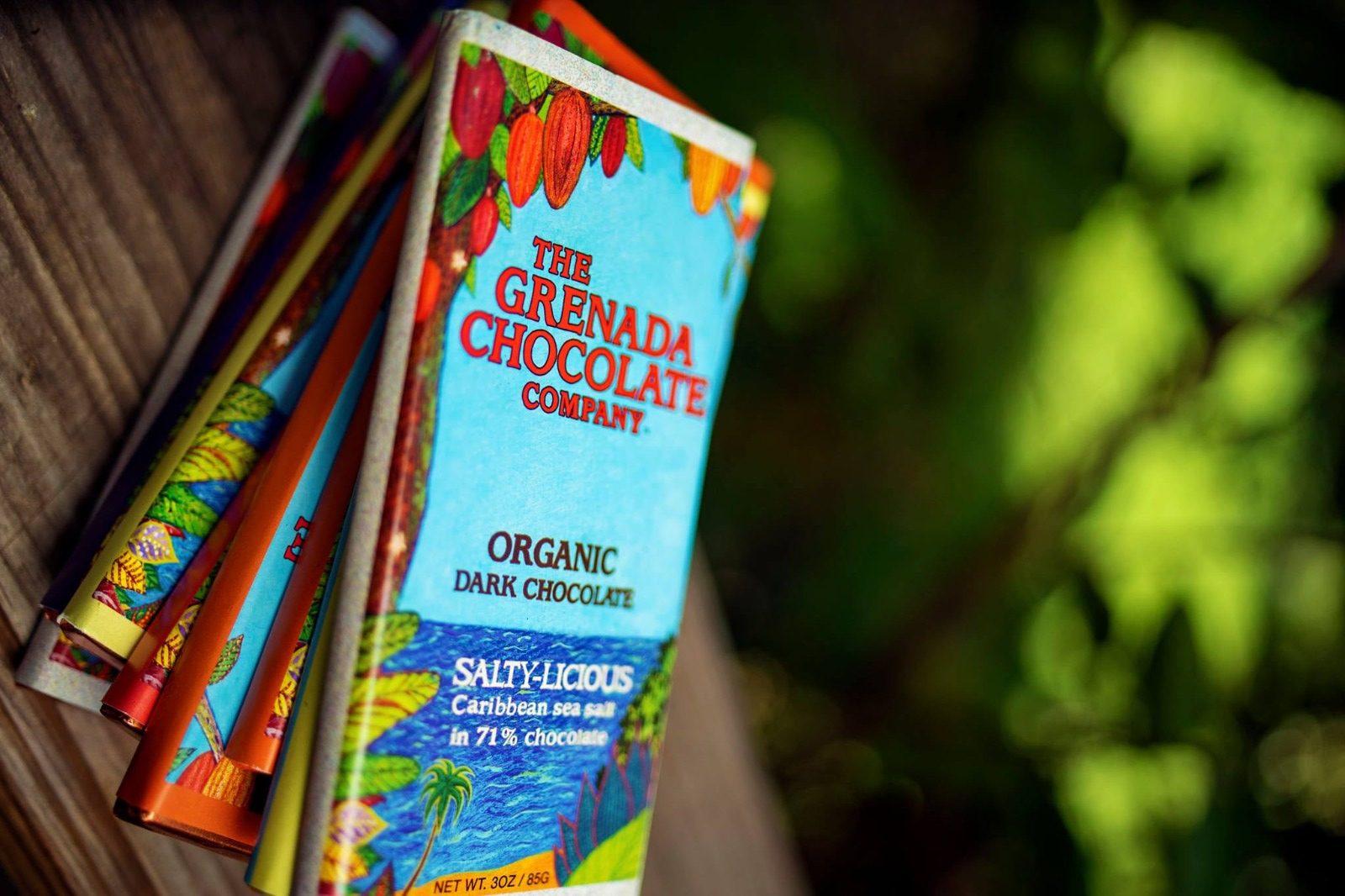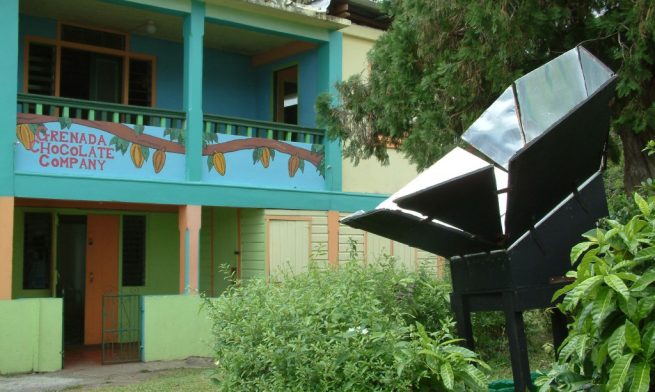At The Grenada Chocolate Company, we take pride in every step of our chocolate-making process. From the moment we harvest the cocoa pods to the final molding of our exquisite bars, every stage is carefully curated to ensure a truly exceptional chocolate experience.
Freshly harvested cocoa
We grow, pick and open our own cocoa pods and then transport the “wet” cocoa to our fermenting and drying facilities.

Fermenting & Drying
The cocoa beans grow inside large pods which contain a pulpy white fruit. In order for the chocolate flavor to develop the beans must ferment in their fruity covering. This fermentation process creates the very complex flavor of chocolate but no alcohol remains. The fermentation is encouraged by placing the fresh “wet” cocoa in a wooden box covered with banana leaves. Mixing and moisture adjustment are performed daily for about 6 days. The proper drying must be implemented immediately after the fermentation period ends for successful flavor development. We dry our beans naturally using the sun and breeze.
Here in Grenada, right where the cocoa grows, we have a distinct advantage over most other chocolate-makers in that we can do our own fermenting and drying. This allows us to determine how to achieve the best and most interesting flavor spectrum from our beans, one of the delicious differences of GrenadaChocolate.
Roasting
The proper degree of roast is essential. Too heavy or too light a roast of beans will not produce tasty chocolate and the margin is small. Roasting cocoa consequently requires close attention and a keen sense of taste and smell of the roaster operator.
Winnowing
Winnowing is the process of removing the outer shell from the cocoa beans. We refurbished a Spanish-made antique winnowing machine, converting it to run with our factory solar-power system. The machine first cracks the roasted cocoa beans into pieces of cocoa meat and shell. The pieces are sent cascading down a series of screens by means of vigorous vibration. As they fall through chutes under the screens, a vacuum system sucks away all the shell and dust material and forces it into a collection bag. The pieces of cocoa bean meat or “nibs,” as they are called in the chocolate-world, fall through the chutes and into collection buckets and are ready for grinding.
Grinding
We use a European vintage chocolate grinding machine called The Melangeur. It’s basically two giant revolving granite rollers on top of a revolving granite slab. The intense grinding action of the heavy rollers tearing across the slab as they rotate converts the cocoa nibs (roasted bean pieces) to a thick oily paste and finally a thick liquid. Heat is added to the machine to facilitate the liquification.
The resulting thick cocoa bean liquid is called cocoa “liquor” and is over 50 percent fat. It is either used at this stage for cocoa butter pressing or is mixed and re-ground with sugar in the Melangeur to make chocolate.
We refurbished our antique Melangeur, adding a solar-powered drive system.
Mixing with sugar
The sugar is well mixed into the liquid cocoa using our Melangeur. Both the sugar and cocoa solid particles are ground down smaller and smaller while more and more fat is released from the cocoa. The sugar/cocoa mixture becomes smoother and remains a thick liquid known as chocolate “paste,” now ready for the refining and conching process to follow.
Refining & Conching
We use a professional conche/refiner machine that combines both of these processes into one. The first period of time in the machine is the refining stage, during which time the conching effect occurs simultaneously. The heat generated from the grinding action of the machine helps heat the chocolate to the conching temperature. During the following period of time, chocolate mixing, agitating and heating continues (conching) until the final flavor is achieved. The chocolate is drained out of the machine and poured into our tempering/depositing machine for the final stage of our long process.
Tampering
Tempering chocolate is the process that creates the desired crystalline structure in the solid chocolate, which is essential to achieve the desired qualities in the finished chocolate: a high melting point so the chocolate melts in your mouth but not in your hands, an attractive glossy finish and a stability that keeps the chocolate this way.
Some technical background is required to understand chocolate tempering. Chocolate, or more specifically the cocoa butter in the chocolate, is “polymorphic.” This means that when liquid chocolate crystallizes (solidifies) it may do so in several different ways depending on the manner in which it is cooled. Because cocoa butter contains many different kinds of fat, there are several possible crystal forms (shapes) that can form during solidification. Only one of these possible crystal forms, known as form IV, has those qualities we desire in chocolate.
When we temper chocolate we are establishing the “seeds” (tiny solid crystals in the liquid chocolate mass) for this crystal form. We “seed” by lowering the temperature of the finished liquid chocolate to about 85 degrees F. while applying continuous mixing. At this seeding temperature relatively small crystals form which are desired to create a fine-grained solid chocolate with the desired “snap.” After allowing seeding to occur, the liquid chocolate’s temperature is raised to about 90 degrees F. to melt out any unwanted seeds, i.e. crystals with the wrong shape that may have also formed. At 90 degrees F. the desired form IV crystals do not melt but the other crystal forms do melt away back into liquid. The liquid chocolate is now tempered and will remain tempered as long as the temperature remains about 90 degrees F. and mixing continues. Even though 90 degrees F. is below the freezing point of the tempered chocolate, the constant mixing prevents solidification from occurring much like the way running water below 32 degrees F. doesn’t freeze.
We temper, mold and wrap our chocolate inside our air-conditioned, ultra-clean tempering room to assure that our products are stable and attractive.
Molding
The final stage of our chocolate-making process is the solidification of the finished and tempered liquid chocolate into our chocolate bars and SweetyPodsTM.
We use a DEPOSITOR of our own design that we built into our Tempering Kettle. Our Depositor allows us to set the volume of chocolate delivered each time it is activated so that we can efficiently make our bars consistent in size. The filled molds are placed on our VIBRATION TABLE, which shakes the chocolate for a few seconds allowing it to evenly fill the mold cavity and release air bubbles. Then the molds are placed on our cooling racks to solidify. After about twenty minutes the molds are turned upside down to release the finished solid chocolate bars which are then wrapped by hand in our special packaging and put away to age.
It is very important to age chocolate for several weeks before selling because, as with most fermented foods, the flavors change drastically during this period. Chocolate takes on its full level of desired wonderful taste only after this aging period.


